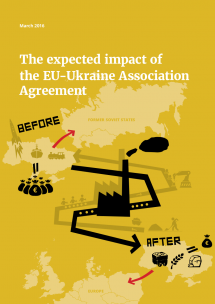The expected impact of the EU-Ukraine Association Agreement
Regions
On 6 April 2016, the Netherlands voted in a referendum on the EU’s Association Agreement (AA) with Ukraine. The referendum was a special democratic event – 427,939 signatures of citizens were collected to make it possible. With a turnout of 32.2%, just above the 30% threshold, the vote was valid. The deal was rejected by 61.1% of votes, compared with 38.1% in favour.

Downloads
Authors
The projected economic and social costs of the Association Agreement for Ukrainians
• Enriches an oligarchic economy where large sectors of the economy’s wealth are siphoned off into offshore trusts
• Contributes to deindustrialising Ukraine, because its industrial producers will struggle to meet EU standards and lack sufficient capital and technology to compete with EU multinationals
• Reinforces a Ukrainian economy based on agro-exports and raw commodities, with less value-added benefits for the population
• Harms Ukraine’s critical small business sector that constitutes 99.8% of all Ukrainian enterprises and accounts for 67.8% of employment
• New jobs created by EU investments are unlikely to compensate for losses by Ukraine’s domestic business sector and EU investors will exploit Ukraine’s lower and frequently unenforced social and environmental standards
• Contribute to the ongoing brain drain as highly educated workers migrate to the EU. Between one third and one quarter of the Ukrainian work force is currently already working abroad
The Transnational Institute conducted a background analysis that explains why, from an economic point of view, the Association Agreement would be a bad deal for ordinary people, both in Ukraine and the EU.
There are many reasons to be concerned about an Association Agreement with Ukraine, but this report focuses on one area, which is the impact that it will have on the Ukrainian economy and therefore its people at a particularly delicate political moment in the country’s history. We focus on this area as the bulk of the Agreement is made up of a deep and comprehensive trade agreement, even if it is also accompanied with other agreements on foreign and security policy, financial cooperation and so on.
In preparing this report, TNI worked closely with Ukrainian researchers based at the Center for Social and Labor Research in Kiev. They have provided the original research for this report as part of a more comprehensive study that was drafted in close collaboration with the Rosa Luxemburg Foundation in Brussels. The Center for Social and Labor Research shares with the Rosa Luxemburg Foundation and TNI a strong concern for democratic, social and labour rights.
Since 2013, the CSLR have been documenting growing levels of state repression of peaceful protests by Ukrainians fighting for social, economic and civil rights. In our collective view, the Association Agreement’s core component, the Deep and Comprehensive Free Trade Area (DCFTA), is premature and problematic and will only benefit a number of Ukraine’s elite at a cost to the majority.
The DCFTA demands almost full abolition of tariffs for trade in goods, extensive liberalisation to allow for enhanced market access for European service providers, and enhanced protection for foreign investors and liberalisation of capital flows. What this means is a complete opening up of Ukraine’s economy to competition from powerful European multinationals, at a time when Ukraine’s domestic economy is in no condition to hold its own.
Many key sectors in Ukraine, notably industrial production, are traditionally oriented towards exporting to Russia and the other states of the Eurasian customs union, based on Russian standards of production. These sectors will struggle to reorient themselves towards exporting to the EU because standards differ widely. The economy as a whole suffers from a crisis in innovative development and requires urgent injections of capital to pay for new technologies and to modernise existing equipment. However, domestic prospects for innovative development remain limited because of cuts to research and development budgets.
While Ukraine’s exports used to mainly comprise of high-tech goods destined for the Russian market, the new orientation towards the EU is already leading to a rise in the export of raw materials and agrofood products. The exports to the EU only partially compensate the loss of exports to the former Soviet states, because of the larger share of lower value added unprocessed goods . Deindustrialisation of the economy looms. The balance of payments is set to worsen, as is Ukraine’s gross external debt, which rose from 88% in 2014 to 155% of GDP in 2016.